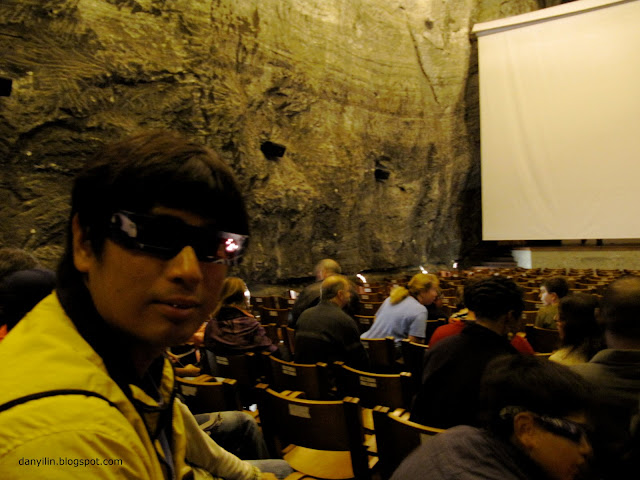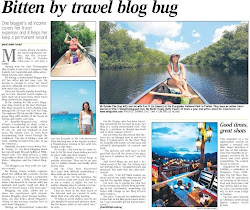As mentioned before, for the first 3 months of our trip, we ate our way through all the fast food chains (MacD's, KFC, Taco Bell, Wendy's, Arby's, Domino's), IHOPs and Ben & Jerry freezers throughout the United States. The good thing is - fast food is the cheapest meal option The bad (very very bad) thing? All those burgers, pizzas, fries and ice-cream flooded our bodies with fat, thousands of calories and icky bad cholesterol.
Our health situation isn't much better here in Colombia. Alot of the food we eat is deep fried - roadside snacks, fried plantains (similar to goreng pisang) and grilled meats.
Shaping Up
"You guys should try getting some exercise!" I hear you say. Except for the daily exertion on our lungs from plodding uphill back to our hostel at this high altitude, and short of signing up for a membership at a home gym (no big California Fitness and Fitness First chains here), going for a jog in Bogota is simply not an option. The air is severely polluted and blackened from the toxic fumes spewed out from collectivos and buses, and ever-rampant cigarette smoke. I fear for my lungs every time we step out onto the street. The pavements are crowded with mime artists (yes, irritating clowns who insist on trailing you and imitating your every action, and expect you to pay them for it), vendors spreading their wares on the ground, spray-paint artists, touts shoving everything from thumb drives to menus in your face and the alluring combo of potholes, spittle and pigeon poop. We are looking forward very much to moving into the countryside once our Spanish lessons end.
Looking Inwards
That said, regular exercise can only target one of the problems brought upon by an unhealthy diet - it only burns excess calories. What about all the bad cholesterol that's trapped inside your body? How do you get that damned evil stuff out?
To recap, how is bad cholesterol harmful to our health? While moving through your body via your bloodstream, the cholesterol decides that it likes the snug environment of your arteries and happily makes itself a permanent home on your artery walls. With the intake of more fatty foods, this spot of prime real estate attracts more fat neighbours. Unlike the traffic situation in Singapore, there's no equivalent of Electronic Road Pricing strategies in your body to regulate the speed at which the fatty deposits are building up. As a result, your arteries start to get dangerously narrow. This is what increases your risk of getting a heart attack.
So, just like how you take care of your car - by giving it a good scrub on the outside and cleaning out the interior (all those errant chips and cookie crumbs) - you not only need to care for your body by showering everyday (even if it means freezing your toes off in chilly Bogota), you also need to flush out those toxic residents that are throwing a weekly neighbourhood party in your arteries.
Cleaning On The Go
How do we take care of our insides while on the go, without (1) starving ourselves silly on a self-imposed detox diet (and missing out on all the great local food); and (2) signing up for expensive and time-consuming professional detox treatments?
We take Forever Living Arctic-Sea Omega-3 capsules as a dietary supplement.
 Forever Living Arctic-Sea Omega-3 capsules - your Heart's best friend
Forever Living Arctic-Sea Omega-3 capsules - your Heart's best friend
Omega-3 is a fatty acid present in the layer of oil that lies under the skin of certain types of fish, namely salmon and mackerel. Also known as "good cholesterol", these fatty acids play a part in reducing the risk of contracting heart disease by countering the influx of bad cholesterol. In the case of Forever Living Arctic-Sea Omega-3 capsules, each 1000 mg capsule comprises 75% pure fish oil and 25% olive oil.
Why olive oil too? Olive oil contains Omega-9, which enhances the rate at which Omega-3 works to reduce cholesterol levels. Our friend Jasmine demonstrated this fact to us through an interesting experiment involving some Styrofoam. Styrofoam has a chemical structure similar to that of bad cholesterol. When oil from an Arctic-Sea capsule was added to the Styrofoam, the Styrofoam immediately started to dissolve. The conclusion is quite clear: the rare combination of Omega-3 and Omega-9 in a single capsule helps to dissolve solid fat deposits in the arteries. Liquid toxins are more easily flushed out of the body than chunks of fat. Regular intake of Arctic-Sea thus helps to keep the arteries clear and open, which optimises the flow of blood - and thus oxygen - to the heart.
There's Lots of Fish in the Sea
Exactomento. Omega-3 supplements are a dime a dozen in pharmacies. But where is the fish oil coming from? The polluted sea near you? Or unhealthy farm-reared fish, all packed fin-to-fin in grimy tanks? As you can imagine, the quality of the oil extracted from fishes living in such poor conditions can't be very good.
As clearly stated in the product name, Forever Living's Omega-3 is harvested from fish living in the Arctic Sea, whose remote location and severe icy temperatures work together to keep human activity at bay and its waters unpolluted. The Arctic waters are partially covered in ice throughout the year, and almost completely so in winter. To survive in such harsh conditions, its fishy residents need to store substantial layers of oil under their skin to insulate themselves against the cold. Healthy fish roaming freely in unpolluted waters, all warm and cosy under their thick oily coats? Paints a pretty picture indeed! So, in order to harvest their bounty of plentiful high-quality oil, we... kill them? Uh-huh. No fishes are harmed in the oil extraction process. Forever Living simply extracts the oil from under their skin and releases the fish back into the ocean, unharmed. To avid divers like us (and all you nice, kindhearted people out there!) who believe in the motto "Fish Are Friends, Not Food", that is good news indeed.
The Comparison With Brand X
Yeah, but how do we know for sure that Forever Living Arctic-Sea capsules work better than aaallllll the other brands of Omega-3 dietary supplements out on the market? Well, to be honest, we don't. Simply because we haven't eaten Omega-3 from aaalllll the other brands and we don't know anyone who is crazy enough to do so.
But take my dad's word for it. Prof Tan is The Ultimate Hypochondriac who indulges in an occasional serving of char kway teow, durian pengat, cereal prawns, chendol and buttery goodies that my mum churns out from her oven. He has been taking Omega-3 capsules since ... forever. We gave him a bottle of Artic-Sea capsules to try. After a month, he excitedly reported that he preferred Forever Living's capsules over his Brand X ones because:
(1) Forever Living's soft gel capsules were easier to swallow than Brand X's hard, plasticky rugby balls that stabbed at his throat on their way down;
(2) they helped him poop better (sorry Dad, you were so excited about this - I just had to say it);
(3) as a result of point (2), he felt lighter, cleaner and more energetic; and
(4) ever since he started taking Arctic-Sea, he has not fallen ill (my dad's very prone to the sniffles and sore throats) even though a recent bout of the dreaded Office Flu wiped out his entire department.
Don't Miss The Boat!
It's never too early to start taking care of your heart and keeping heart disease at bay. If anyone is interested in getting on track to a healthy heart, drop our friend Jasmine a note by clicking here or emailing her at jasjas.ng@gmail.com. Don't just stop at the heart though - Jas knows some professional nutritionists who can help do a thorough check of your insides too!
 Hundreds and hundreds of icky pigeons. We had to guard our food and drinks (especially ice-cream!) closely to prevent errant feathers from sticking to them. The beautiful Catedral Primada and the smaller Capilla del Sagrario in the background.
Hundreds and hundreds of icky pigeons. We had to guard our food and drinks (especially ice-cream!) closely to prevent errant feathers from sticking to them. The beautiful Catedral Primada and the smaller Capilla del Sagrario in the background.  Dan, flanked by the Capitolio Nacional (the seat of the Congress) in classical Greek style and the French-style Alcaldia (mayor's office)
Dan, flanked by the Capitolio Nacional (the seat of the Congress) in classical Greek style and the French-style Alcaldia (mayor's office) Against a backdrop of 3 churches in a row - Inglesia de San Francisco, Inglesia de la Veracruz and Inglesia La Tercera
Against a backdrop of 3 churches in a row - Inglesia de San Francisco, Inglesia de la Veracruz and Inglesia La Tercera A very grand-looking school compound we pass by everyday when walking from the hostel to the city streets and back
A very grand-looking school compound we pass by everyday when walking from the hostel to the city streets and back An interesting tile painting on Calle 10 - a paved pedestrian mall. The lower part of the street is heavily patrolled by military police 24/7. The upper part - don't go there. The robbers will get you. They got us.
An interesting tile painting on Calle 10 - a paved pedestrian mall. The lower part of the street is heavily patrolled by military police 24/7. The upper part - don't go there. The robbers will get you. They got us.  The narrow streets in La Candelaria are flanked by old buildings in pretty colours. They help distract us from the harrowing uphill walk that leaves us panting everytime. Many of the buildings house beautiful airy courtyards bathed in natural light (and chilly air) - similar to shophouses in Singapore.
The narrow streets in La Candelaria are flanked by old buildings in pretty colours. They help distract us from the harrowing uphill walk that leaves us panting everytime. Many of the buildings house beautiful airy courtyards bathed in natural light (and chilly air) - similar to shophouses in Singapore.  I wonder whether there's actually a room behind those windows. Seems funny to build a wall for the sake of holding up 2 fancy bay windows. Or maybe the entire second floor was demolished and all that's left is the facade?
I wonder whether there's actually a room behind those windows. Seems funny to build a wall for the sake of holding up 2 fancy bay windows. Or maybe the entire second floor was demolished and all that's left is the facade?  One of the many museums in the area. Entrance is all free-of-charge
One of the many museums in the area. Entrance is all free-of-charge Sunset casting an orange glow on the buildings. Flags all unfurled in celebration of Colombia's Independence Day
Sunset casting an orange glow on the buildings. Flags all unfurled in celebration of Colombia's Independence Day Spectacular sunset
Spectacular sunset








































































